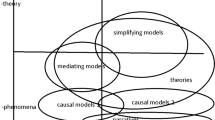Abstract
Knowledge of many facts does not amount to understanding unless one also has a sense of how the facts fit together. This aspect of coherence among scientific observations and theories is usually overlooked in summaries of scientific method, since the emphasis is on justification and verification rather than on understanding. I argue that the inter-theoretic coherence, as the hallmark of understanding, is an essential and informative component of any accurate description of science.
Similar content being viewed by others
References
Armstrong D. (1983), What Is a Law of Nature?. Cambridge, Cambridge University Press
Bhaskar R (1975), A Realist Theory of Science. Leeds, Leeds Books
Collingwood R.G (1946), The Idea of History. Oxford, Oxford University Press
Daumal R (1979) (original in French, 1938), A Night of Serious Drinking. Boulder, Shambala
de Regt H., Dieks D. (2005), A Contextual Approach to Scientific Understanding. Synthese 144: 137–170
Dretske F (1977), Laws of Nature. Philosophy of Science 44: 248–268
Duhem P (1954), The Aim and Structure of Physical Theory. Princeton, Princeton University Press
Elgin C (1996), Considered Judgment. Princeton, Princeton University Press
Kitcher P,: (1989), Explanatory Unification and the Causal Structure of the World. In P. Kitcher and W. Salmon (eds.), Scientific Explanation. University of Minnesota Press, 410–505
Kosso P, (1996), Scientific Method and Hermeneutics. The Southern Journal of Philosophy 34: 169–182
Longrigg J (1998), Greek Medicine from the Heroic to the Hellenistic Age. New York, Routledge
McAllister J (1996), Beauty and Revolution in Science. Ithaca, Cornell University Press
Newton R (1997), The Truth of Science. Cambridge MA, Harvard University Press
Salmon W (1998), Causality and Explanation. Oxford, Oxford University Press
Schurz G., K. Lambert (1994), Outline of a Theory of Scientific Understanding. Synthese 101: 65–120
Swoyer C (1985), The Concept of Physical Law. Cambridge, Cambridge University Press
Thucydides (1985), History of the Peloponnesian War (translated by C.F. Smith). Cambridge MA, Harvard University Press
Toulmin S (1961), Foresight and Understanding. New York, Harper & Row
van Fraassen B, (1989) Laws and Symmetry. New York, Oxford University Press
Weinberg S (1992), Dreams of a Final Theory. New York, Random House
Weinert F (1993), Laws of Nature. Philosophia Naturalis 30(2): 147–171
Author information
Authors and Affiliations
Corresponding author
Rights and permissions
About this article
Cite this article
Kosso, P. Scientific Understanding. Found Sci 12, 173–188 (2007). https://doi.org/10.1007/s10699-006-0002-3
Published:
Issue Date:
DOI: https://doi.org/10.1007/s10699-006-0002-3



